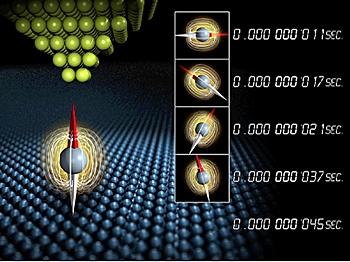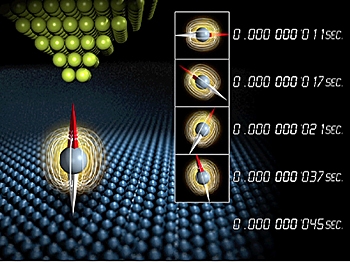A new technique can measure how long a single atom can hold information and allows researchers to actually record, study, and visualize the magnetism of individual atoms at speeds 1 million times faster than previously possible.
To perform this breakthrough, scientists employed a Scanning Tunneling Microscope—a technology nearly three decades old. Scientists at IBM recently published their findings in the Sept. 24 edition of the journal Science.
“The technique has great potential because it is applicable to many types of physics happening on the nanoscale,” said IBM Research scientist, Sebastian Loth in a press release.
Scientists say that this new technique could soon lead to engineering improvements in applications such as solar cells, information storage technologies, and quantum computers—creating machines with the potential to perform advanced computations not possible today.
Researchers explain that the magnetic spin of an atom changes at a speed so fast that previously available Scanning Tunneling Microscope techniques could not keep pace. The new technique utilizes the microscope like a high-speed camera, recording time-dependent behavior stroboscopically. Scientists say the result is similar to time lapse photography.
Researchers employed an alternating voltage technique called “pump-probe” to obtain their measurements. Using a fast voltage pulse (pump), scientists excite the atom, while a subsequent weaker voltage pulse (probe) measures the orientation of the atom’s magnetism at a certain time following the excitation. The time delay between the two pulses sets the frame time of each measurement.
To perform this breakthrough, scientists employed a Scanning Tunneling Microscope—a technology nearly three decades old. Scientists at IBM recently published their findings in the Sept. 24 edition of the journal Science.
“The technique has great potential because it is applicable to many types of physics happening on the nanoscale,” said IBM Research scientist, Sebastian Loth in a press release.
Scientists say that this new technique could soon lead to engineering improvements in applications such as solar cells, information storage technologies, and quantum computers—creating machines with the potential to perform advanced computations not possible today.
Researchers explain that the magnetic spin of an atom changes at a speed so fast that previously available Scanning Tunneling Microscope techniques could not keep pace. The new technique utilizes the microscope like a high-speed camera, recording time-dependent behavior stroboscopically. Scientists say the result is similar to time lapse photography.
Researchers employed an alternating voltage technique called “pump-probe” to obtain their measurements. Using a fast voltage pulse (pump), scientists excite the atom, while a subsequent weaker voltage pulse (probe) measures the orientation of the atom’s magnetism at a certain time following the excitation. The time delay between the two pulses sets the frame time of each measurement.







